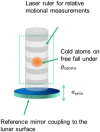Quantum sensing for NASA science missions
- PMID: 40416824
- PMCID: PMC12095411
- DOI: 10.1140/epjqt/s40507-025-00360-3
Quantum sensing for NASA science missions
Abstract
The National Aeronautics and Space Administration (NASA) develops a broad range of technologies to support space-based quantum sensing and communications, uses the space environment to study fundamental quantum processes to advance our knowledge of physics, and develops algorithms to attack complex science problems that might be solved using quantum computing. This paper describes quantum sensors that NASA has flown on space missions, investments that NASA is making to develop quantum sensors, and possible approaches to employ quantum sensing to study the attributes of distant stars and planets, the Sun, Earth, and fundamental properties of matter.
Keywords: Earth science; Quantum sensing; Remote sensing; Space science; Spacecraft.
© This is a U.S. Government work and not under copyright protection in the US; foreign copyright protection may apply 2025.
Conflict of interest statement
Competing interestsThe authors declare no competing interests.
Figures




















References
-
- Slocum RE, Reilly FN. Low Field Helium Magnetometer for Space Applications. IEEE Trans Nucl Sci 1963;10(1). https://ieeexplore.ieee.org/document/4323257. Accessed 28 Dec 2024.
-
- Smith EJ, Jones DE, Davis L Jr, Coleman PJ Jr. Magnetometer Experiment. NASA News Release 65-117-B. 1965. Magnetometer experiment - NASA Technical Reports Server (NTRS). Accessed 30 Dec 2024.
-
- Connor BV. Space Magnetics: the Mariner V Magnetometer Experiment. IEEE Trans Magn. 1968;MAG–4:3. https://ieeexplore.ieee.org/stamp/stamp.jsp?tp=&arnumber=1066331. Accessed 28 Dec 2024.
-
- Smith EJ, Connor BV, Foster GT Jr. Measuring the Magnetic Fields of Jupiter and the Outer Solar System. IEEE Trans Magn. 1975;MAG–11:4. https://ieeexplore.ieee.org/stamp/stamp.jsp?tp=&arnumber=1058779. Accessed 28 Dec 2024.
-
- Aveline DC, Williams JR, Elliott ER, Dutenhoffer C, Kellogg JR, Kohel JM, Lay NE, Oudrhiri K, Shotwell RF, Yu N, Thompson RJ. Observation of Bose-Einstein condensates in an Earth-orbiting research lab. Nature. 2020;582:193–7. 10.1038/s41586-020-2346-1. - PubMed
Publication types
LinkOut - more resources
Full Text Sources
